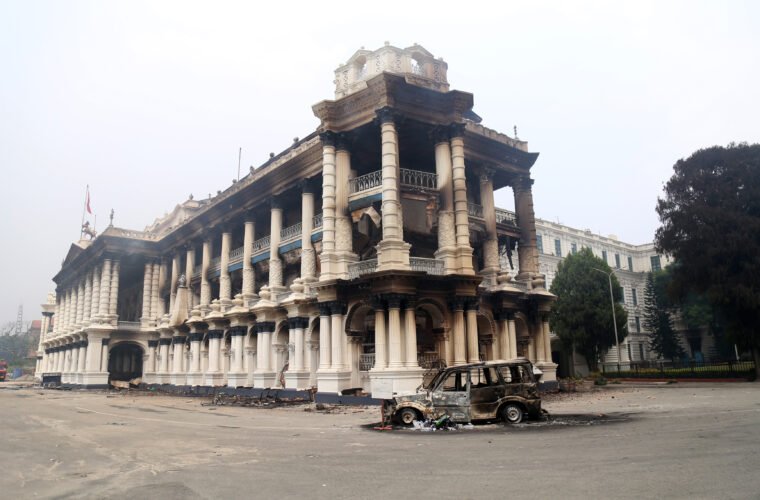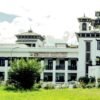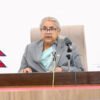By Hannah Beech and Sajal Pradhan
Many of Nepal’s trappings of state went up in smoke in a single afternoon. On Sept. 9, coordinated arson attacks across the Himalayan nation destroyed hundreds of government buildings, from a storied palace and top courts to grand ministries and humble ward offices. Hundreds of other properties were targeted, too, including businesses and schools connected to the political elite, as well as homes of current and retired politicians.
The widespread arson followed the fatal shootings the day before of 19 anti-corruption protesters by security forces in Kathmandu, the capital. The prevailing narrative is that mobs of young protesters sought retribution, setting fires as their outrage over the killings flared.
But a New York Times investigation — based on dozens of interviews with witnesses, participants and arson experts; a review of photos and videos from the havoc; and visits by The Times to the wreckage sites — reveals new details that cast doubt on the idea that such a tightly coordinated nationwide campaign of destruction could have been an entirely spontaneous response to the deaths the day before.
A few hours after the shootings on Sept. 8, “ready-to-use lists” began surfacing online with the private details of members of society accused of being part of Nepal’s graft and patronage network.
The next afternoon, most of these people’s residences began to burn. Nepal’s executive, legislative and judicial branches were also consumed by fire. The scale of the devastation was catastrophic, akin to hundreds of airstrikes in a handful of hours.
Fires at key buildings in Kathmandu on Sept. 9
“You don’t get so many buildings on fire in a short time frame without a good deal of organizational prowess,” said Richard Hagger, a senior fire investigator at Andrew Moore & Associates. “Something like that takes weeks, if not months, of planning.”
The crowds that attacked the heart of the Nepali government marauded largely unimpeded other than around the Parliament complex, which was guarded by a contingent of riot police. Nepali troops, who were barely seen on the streets that day, had been told not to intervene, four people with direct knowledge of the matter said. They, as well as other witnesses and officials interviewed for this article, talked to The Times on condition of anonymity because they had not been approved to brief the public or were worried about retaliation.
The bedlam on Sept. 9 was punctuated by the resignation of Nepal’s prime minister. Soon, the government fell. Nepal’s bureaucracy was charred. In Kathmandu and its suburbs, more than 110 police stations were set on fire, according to a police spokesman. The damage and lost business is still being tallied, but initial estimates put it at more than a third of Nepal’s gross domestic product, one cabinet minister said.
Fire investigators caution that it is impossible to reconstruct what happened on Sept. 9 without testing debris samples, interviewing witnesses and examining the buildings. Yet none of this vital analysis has been conducted by the police lab that normally handles such cases. It is unclear whether the official inaction is the result of any specific orders. But with each day, it is less likely that science can determine who burned down Nepal’s government, how it was done and why.
Pawan Dhungana, a section chief of the Nepali police’s central forensic science lab, confirmed that no one in his team has been called to investigate since the fires blazed last month. His lab has received nothing to test. Any fire debris has probably degraded to the point of irrelevance, he said.
“Seeing all these conflagrations, not just in Kathmandu but all around the country, one can suspect it was preplanned,” Mr. Dhungana said. “Of course, we don’t have any evidence of anything.”
The interim government of Prime Minister Sushila Karki has formed a commission to investigate the mass fires and the excessive use of force against the protesters. But another Nepali forensic police officer said that Nepal’s judicial backlog means that it could take up to seven years for any investigation to be completed. Nepali business associations have urged far faster action to restore investor confidence. No one has claimed responsibility for the fires, although theories have spread as fast as the blazes did.
On Sept. 9, the throngs moved within two hours from Parliament to the Supreme Court to the Singha Durbar complex, with its former palace and about 20 government ministries. The main building began smoking within half an hour of the crowd’s arrival, witnesses said. Such a rapid ignition, followed by flames that seemed more intense than those fed simply by interior furnishings, suggests trails of specialized accelerants were laid beforehand to create a so-called fire path, arson experts said.
“Looking at photographs, I suspect that sodium or magnesium or other chemicals were used because of the size of the conflagrations,” Mr. Dhungana said. “But without analyzing, we cannot say anything for sure.”
These chemicals are controlled substances and require expertise to deploy. They cannot be purchased easily like more common accelerants, such as kerosene. But many gallons of liquid fuel would still be needed to ensure that big buildings burn.
Notably, some of the building’s upper windows were open when the mobs arrived, which they usually were not, according to workers there.
This ventilation likely helped the fire to spread, arson experts said. But whether this was done deliberately cannot be determined without on-the-ground detective work.
“The factors to say more likely than not that it was some sort of organized conspiracy are the size of the building, the devastation of the building, the ferocity of the fire,” said Kenneth Kee, a principal consultant at Fire Science Forensics in Singapore. “Then you have to ask: ‘How did the accelerants get in the building? Was it an inside job? Did security abandon their posts?’”
Elsewhere in Kathmandu and in towns all across Nepal, the mobs worked more openly. They followed the lists that had circulated the night before. The targets included the homes of Nepal’s political grandees, including the top ranks of the three big political parties — the Nepali Congress, the Maoists and the Communists. (Cases of mistaken identity were mixed in, too.) These arsonists were armed with containers of fuel and bottles capped with cloth wicks, witnesses and participants in the violence said. Some carried sticks, rifles and kukris, a local curved dagger.
Three young men who took part in the arson said that they worked in shifts that day and that older men they did not know handed out petrol bombs filled with motorcycle fuel. Two of them shared videos of the attacks. Neighbors living next to one of the targeted homes said they saw a group of men in their mid-30s disgorging the contents of gas canisters. Seeing the flames shoot up, one perpetrator remarked that this meant they would be getting paid, the neighbors said.
Arson has been a fixture of Nepali political culture. During their decade-long insurgency against the now-abolished monarchy, Maoists set fires and rigged explosives, targeting symbols of the state or powerful businesses. Deliberate fires continued after the civil war ended in 2006. In 2019, for instance, the Communists, who splintered from the Maoists, admitted to setting on fire more than a dozen cellular towers across the nation to protest supposed corruption by the telecom operator.
None of the big three political parties was spared this time around. Those who escaped the destruction included the fourth- and fifth-largest parties, one headed by a politician who was part of a mass jailbreak on Sept. 9 and the other a pro-royalist bloc. About 60,000 case files at the Supreme Court burned, even those supposedly protected by fire-resistant boxes, a court employee said. At the anti-corruption court, members of the mob yelled out, looking for rooms holding specific documents, two lawyers said.
Business owners in several cities said that the arsonists set fires on alternate floors, a tactic to link blazes, which could point to systematic attacks, fire experts said.
Even the central police forensic lab was besieged by men throwing petrol bombs. The fire did not catch, and the lab was unscathed.
“We all want to know who did this,” Mr. Dhungana said. “But it’s almost like we cannot find out.”
From: nytimes





